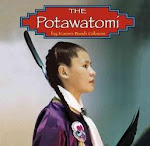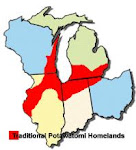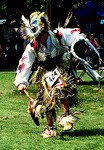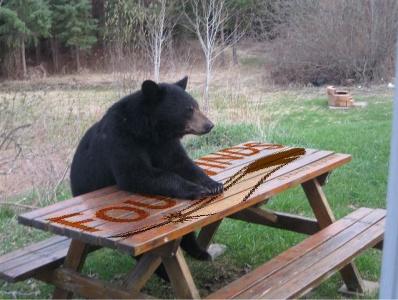and the Potawatomi
Little has ever been written about The Great Depression and how it affected the Potawatomi living on the reservation.
In the early days of the Potawatomi tribes, long before the Europeans journeyed to the shores of this great continent, stories about the early history, culture and traditions were told and passed on to future Potawatomi around campfires. These stories would eventually become known as oral history and still remains a strong part of the cultural history of the Potawatomi. These stories are told still today around campfires by elders to the young Potawatomi, so that the history is not forgotten or lost.
While the rest of the country spiraled into a severe and often deadly economic down-turn in 1929, the Potawatomi, honored by a long and hard history had taught it's people how to survive on a reservation by adapting to it's current environment. Federal programs helped the Potawatomi then, and still does today.
Inner strength and a strong character would help the Potawatomi survive on the reservation during the Great Depression. Thus while the world fell apart around them, the Potawatomi banned together and did what needed to be done to survive.
Many of the Potawatomi wrote down their experiences, income, deaths, and the recording of the arrival of new babies in little journals or ledger books that would be passed on to other family members when they passed.
The human suffering became a reality for millions of Americans as the depression continued. Thousands of people lost their homes because they could not pay the mortgage. In 1932, at least 25,000 families and more than 200,000 young people wandered the country in search of food, clothing, shelter, and a job. Many youth traveled in freight trains and lived near yards in camps called hobo jungles. While this happened to many other Americans, the Potawatomi generally stayed on or near the reservation. A key to survival was the ability to improvise.
In one family journal, for instance, it reveals how Hattie Lasley sold chickens, hens, and one rooster for a pittance to buy food for her family. She sold bushels of Potatoes and even helped cut wood for the local farmers. And like so many during this era, she worked a small farm, but it was just enough to make a living.
Luther Wahwasuk, an elderly Potawatomi man, recalled his experience, "I was just in my teens. Around home, we had a helluva time and it was hard to do anything to make money. We had to eat hard-track, a hard cracker, squirrel, rabbit, turtle and had to put up food for future use. We did quite a bit of trapping and skinned out the animals and took them to Topeka and with this money, we would buy .22 ammunition for hunting and Bull Durham." He remembered that even before the depression, there was no money for Potawatomis to lose. So they never learned to distrust banks like so many others in America who lost money when they failed. He also related how the Indian people often had no cars, but did have horse and buggies and wagons. There was no electricity or running water and many people died of tuberculosis.
The most important factor for survival was that the Potawatomi helped each-other and could count on each-other. In return they would often have a place to stay and meals for the night. An arrangement that worked out for all.
To compound the economic problems, there was a severe drought that was one of the worst in history. Many Potawatomi depended extensively on gardens. grasshoppers then came and one of the worse grasshopper invasions happened in Kansas during 1936, and killed many gardens.
In many parts of the country, many farmers refused to ship the Potawatomi products to market. the severe weather conditions and other factors would eventually lead to the demise of the Potawatomi farmer.
Many Potawatomi raised chickens, milked cows and grew gardens still when ever possible. Additionally, hunting of wild game, a popular pastime on the reservation, then and still now, helped in trying times.
Another form of recreation was ventured around a place called "Big Solider Playground" located near Big Solider Creek. Here tribal members gathered to swim and have picnics. The children played on swings, played croquet and raced in 50 yard dashes.
A steady line of work would come to the reservation in the form of programs like the Works Progress Administration (WPA) and the Civilian Conversation Corp (CCC). They became the main work programs on the reservation during the Great Depression.
One such project was the Potawatomi community building completed and dedicated on February 16, 1941. The cost of the building was about $8,546.15. Richard Pahmahmie, Sr. recalled hauling native stone from Big Solider Creek for the project. Caroline Potts described how the barter system worked: In exchange for the native stone extracted from various tribal members' lands near Big Solider Creek, the government would terrace the land, thus improving it for future rent. This way, both parties benefited. The community building turned into a 36 by 60 foot building used for many tribal gatherings such as political meetings, funerals, social events like pow wows, dances weddings and other tribal functions. Before this, tribal events were held at the homes of tribal members. Men worked on these projects part-time, because most projects were shut down during the summer grain harvest and again during inclement winter months.
The Burea of Indian Affairs had an unusual requirement for the men working full-time. It required them to save half their wages to buy food during the winter layoff period. This wasn't a bad strategy, but it was an example of the tight control the bureau had over Indian people's lives.
While the building programs, did benefit the tribal members by providing needed work and housing, some of the Bureau of Indian Affairs tactics were deplorable. The superintendent at the time, H.E. Bruce, maintained control over who worked on the WPA projects. For example, if a tribal member was reported drunk in town or on the reservation, he would be suspended from work for a set number of days or let go.
One way Potawatomi families saved on living expenses was to send their children off to government boarding schools established in places like Seguoyah, Chillocco, Pawnee, Oklahoma and Mount Pleasant. while other children went to South Dakota and Genoa, Nebraska. This had detrimental effects on the tribal members who went through the boarding school experience. Some students lost their language and were even punished for practicing their native tounge or culture.
While the Depression was an aberration in the lives of the people on the Potawatomi reservation, the introduction of more government rules and regulations was no aberration.
Gary Mitchell, Praire Band of Potawatomi, Tribal historian.
shawnosh@yahoo.com
To read more link

In one family journal, for instance, it reveals how Hattie Lasley sold chickens, hens, and one rooster for a pittance to buy food for her family. She sold bushels of Potatoes and even helped cut wood for the local farmers. And like so many during this era, she worked a small farm, but it was just enough to make a living.
Luther Wahwasuk, an elderly Potawatomi man, recalled his experience, "I was just in my teens. Around home, we had a helluva time and it was hard to do anything to make money. We had to eat hard-track, a hard cracker, squirrel, rabbit, turtle and had to put up food for future use. We did quite a bit of trapping and skinned out the animals and took them to Topeka and with this money, we would buy .22 ammunition for hunting and Bull Durham." He remembered that even before the depression, there was no money for Potawatomis to lose. So they never learned to distrust banks like so many others in America who lost money when they failed. He also related how the Indian people often had no cars, but did have horse and buggies and wagons. There was no electricity or running water and many people died of tuberculosis.
The most important factor for survival was that the Potawatomi helped each-other and could count on each-other. In return they would often have a place to stay and meals for the night. An arrangement that worked out for all.
To compound the economic problems, there was a severe drought that was one of the worst in history. Many Potawatomi depended extensively on gardens. grasshoppers then came and one of the worse grasshopper invasions happened in Kansas during 1936, and killed many gardens.
In many parts of the country, many farmers refused to ship the Potawatomi products to market. the severe weather conditions and other factors would eventually lead to the demise of the Potawatomi farmer.
Many Potawatomi raised chickens, milked cows and grew gardens still when ever possible. Additionally, hunting of wild game, a popular pastime on the reservation, then and still now, helped in trying times.
Another form of recreation was ventured around a place called "Big Solider Playground" located near Big Solider Creek. Here tribal members gathered to swim and have picnics. The children played on swings, played croquet and raced in 50 yard dashes.
A steady line of work would come to the reservation in the form of programs like the Works Progress Administration (WPA) and the Civilian Conversation Corp (CCC). They became the main work programs on the reservation during the Great Depression.
One such project was the Potawatomi community building completed and dedicated on February 16, 1941. The cost of the building was about $8,546.15. Richard Pahmahmie, Sr. recalled hauling native stone from Big Solider Creek for the project. Caroline Potts described how the barter system worked: In exchange for the native stone extracted from various tribal members' lands near Big Solider Creek, the government would terrace the land, thus improving it for future rent. This way, both parties benefited. The community building turned into a 36 by 60 foot building used for many tribal gatherings such as political meetings, funerals, social events like pow wows, dances weddings and other tribal functions. Before this, tribal events were held at the homes of tribal members. Men worked on these projects part-time, because most projects were shut down during the summer grain harvest and again during inclement winter months.
The Burea of Indian Affairs had an unusual requirement for the men working full-time. It required them to save half their wages to buy food during the winter layoff period. This wasn't a bad strategy, but it was an example of the tight control the bureau had over Indian people's lives.
While the building programs, did benefit the tribal members by providing needed work and housing, some of the Bureau of Indian Affairs tactics were deplorable. The superintendent at the time, H.E. Bruce, maintained control over who worked on the WPA projects. For example, if a tribal member was reported drunk in town or on the reservation, he would be suspended from work for a set number of days or let go.
One way Potawatomi families saved on living expenses was to send their children off to government boarding schools established in places like Seguoyah, Chillocco, Pawnee, Oklahoma and Mount Pleasant. while other children went to South Dakota and Genoa, Nebraska. This had detrimental effects on the tribal members who went through the boarding school experience. Some students lost their language and were even punished for practicing their native tounge or culture.
While the Depression was an aberration in the lives of the people on the Potawatomi reservation, the introduction of more government rules and regulations was no aberration.
Gary Mitchell, Praire Band of Potawatomi, Tribal historian.
shawnosh@yahoo.com
To read more link
,+Karen+Bush+Gibson,+Ex-+-+eBay+(item+360233250981+end+time+Mar-09-10+19-22-27+PST)_1265816805474.jpeg)



























































